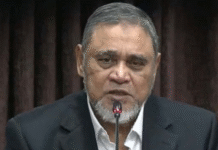
The tunnel built under the Karnaphuli River in Chattogram is not getting as much traffic as expected yet resulting in less than expected toll collection. As of now, the revenue generated from the tunnel is much less than maintenance costs and toll collection.
According to the bridge division, over 4,500 vehicles have used the tunnel every day on average so far. It was predicted that at least four times that number of vehicles would use the tunnel. Daily average income from the toll of the tunnel is Tk 11,80,000 taka. On the other hand, the average daily expenditure for collection and maintenance of this toll is Tk 3.75 million.
The main length of the Bangabandhu Sheikh Mujibur Rahman Tunnel built under the Karnaphuli river is 3.32 km. It is the first under-river tunnel in the country. The tunnel was built with Chinese loans and Bangladesh government funding.
Sources from Bangladesh Bridges Authority said paying the installments of loan taken from China would start from this year. As the income is less than expected, maintenance cost would have to be paid from income generated from other bridges. As a result, the government will have to pay a subsidy from the revenue sector to pay the loan.
The tunnel has eased the commute as crossing the road now takes three to three and half minutes. However, economists , businessmen and bridges authority said the roads on the one side of the tunnel were not widened. The Chittagong Development Authority (CDA) has not taken much initiative to expand the city on the other side of Karnaphuli river. There should be industrialization centering the tunnel. The use of the tunnel could be increased once these initiatives are taken.
Bridges division’s secretary Md Monjur Hossain told Prothom Alo that work to connect Cox’s Bazar and Matarbari with the tunnel is going on. The use of the tunnel and income would increase if it can be connected with Cox’s Bazar and Matarbari roads.
About the repayment of the installment of the Chinese loan, he said the matter is now under the finance ministry.
The first tunnel of country
The project under the name of ‘Construction of multi-lane road tunnel under the river Karnaphuli’ was approved in an ECNEC meeting in November, 2015. The project was supposed to be completed in June, 2020. But the construction began on 24 February in 2019. The project cost was Tk 84.47 billion initially which rose to Tk 106.89 billion finally. Of the amount, China’s Exim Bank provided Tk 67 billion as loan at an interest rate of 2 per cent and service charge of .20 per cent. The payment period is 15 years with a grace period of five years.
Chinese contractor firm China Communication Construction Company (CCCC) built the tunnel. The main condition of a Chinese loan is that only a Chinese contractor can do the work and no tender can be filed. There is an allegation that projects with such conditions are generally much costlier.
The construction of China’s longest underwater highway tunnel—Taihu tunnel—begun in 2018. At a length of 10.79 kilometers, the Taihu tunnel was open to vehicle traffic in January, 2022. According to a report of US media CNN, the tunnel was built at a cost about $1.56 billion. The construction cost per kilometer in Taka was 15.9 billion.
In India’s Mumbai, a two kilometers long tunnel is being constructed under the sea with construction cost per kilometer is Tk 17.79 billion.
Construction cost per kilometer of Karnaphuli tunnel is over Tk 32 billion. Officials of the project claimed that while India and China use its own manpower, machineries and materials, Bangladesh has to import many materials that increases the project cost.
However, experts opine that project cost could have been decreased had the contractor recruited through a competitive process. Road transport expert and Bangladesh University of Engineering and Technology’s (BUET) professor Md Samsul Haque told Prothom Alo that the tunnel construction cost was much higher. Also, the maintenance and operation cost is also very high. If a suspension bridge was constructed over the Karnaphuli river, it would have cost much less money.
How many vehicles use the tunnel?
Prime minister Sheikh Hasina inaugurated the Bangabandhu Tunnel on 28 October last year. The vehicle movement officially started the day after the inauguration. The Chinese contractor estimated that 20,719 vehicles will use the tunnel a day when it opens to the public in 2020. Every year the number of vehicles will increase at the rate of 6.4 per cent. In 2025, an average of 28,305 vehicles will run daily.
The tunnel was opened in 2023 instead of 2020. According to the bridge authority, after the opening till 6 May, only 4,613 vehicles used this tunnel daily on average. So far, around Tk 220 million was collected as toll. The average daily income is Tk 11,80,000 taka. The concerned officials said that the traffic has decreased in recent times compared to the beginning.
Sources in the bridges authority say that heavy vehicles were expected to move more through the tunnel private cars using the tunnel more as of now. Motorcycles and three-wheelers are prohibited to use the tunnel.
Expenditure much more than income
The government has given the responsibility of maintenance and collection of toll for five years to Chinese company CCCC for Tk 9.84 billion (35 per cent in foreign currency). Bridges division officials said of the 9.84 billion to be given to the, Tk 3 billion has been spent on procuring scanners. The actual cost in maintenance in five years is Tk 6.84 billion, or Tk 3.7 million per day.
This shows that the money collected from the toll is around one third of the amount spent in maintenance. Also, the tunnel would require major maintenance every five year which is called ‘regular maintenance’. The study said such major maintenance work would cost around Tk 220 million.
Asked if it will be possible to manage the maintenance cost and loan installment from the income generated through toll, the bridges division’s chief engineer Kazi Md Ferdous said, if the toll is sufficient, then the government will provide subsidy. The money would be paid back to the government once the income from the toll increases.
Narrow roads
The road from Anowara’s Chatri to Y Junction was expanded during the construction of the tunnel but the Chattogram-Cox’s Bazar highway did not see any expansion. Anowara and Banshkhali portions of the Patiya-Anowara-Banshkhali road were not widened. As a result, the Cox’s Bazar-bound vehicles using the tunnel have to travel extra lengths. The distance would shorten by at least 25 kilometers if Cox’s Bazar-bound vehicles can travel via Banshkhali. The issue of expansion of the road is still at the discussion stage.
The government planned to make Chattogram ‘one city two town’ akin to China’s Shanghai. But no steps have so far been visible to expand the city to the south.
Bangladesh Economic Association’s former president professor Muinul Islam told Prothom Alo the tunnel would be best used if a marine drive can be constructed from Chattogram’s Mirsarai to Cox’s Bazar. If marine drive is constructed, many industries would be built along the road.
Otherwise, the tunnel would remain unused, he added.
en.prothomalo









